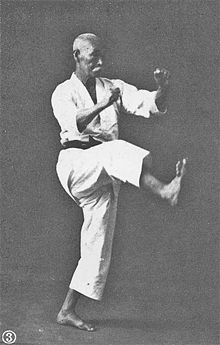Karate do
 |
|

|
|
| Also known as | Karate Do 空手道 |
|---|---|
| Focus | Striking |
| Hardness | Full-contact, semi-contact, light-contact |
| Country of origin | Ryukyu Kingdom |
| Creator | Sakukawa Kanga; Matsumura Sōkon; Itosu Ankō; Arakaki Seishō; Higaonna Kanryō |
| Parenthood | Indigenous martial arts of Ryukyu Islands, Chinese martial arts |
| Olympic sport | Yes (2020 Summer Olympics) |
Karate (空手) (English: /kəˈrɑːtiː/; Japanese pronunciation: [kaɾate]; Okinawan pronunciation: Ryukyuan pronunciation: [kaɽati]) is a martial art developed in the Ryukyu Kingdom. It developed from the indigenous Ryukyuan martial arts (called te (手), "hand"; tii in Okinawan) under the influence of Chinese martial arts, particularly Fujian White Crane. Karate is now predominantly a striking art using punching, kicking, knee strikes, elbow strikes and open-hand techniques such as knife-hands, spear-hands, and palm-heel strikes. Historically, and in some modern styles, grappling, throws, joint locks, restraints, and vital-point strikes are also taught. A karate practitioner is called a karateka (空手家).
The Ryukyu Kingdom was annexed by Japan in 1879. Karate was brought to Japan in the early 20th century during a time of migration as Ryukyuans, especially from Okinawa, looked for work in Japan. It was systematically taught in Japan after the Taishō era. In 1922 the Japanese Ministry of Education invited Gichin Funakoshi to Tokyo to give a karate demonstration. In 1924 Keio University established the first university karate club in mainland Japan and by 1932, major Japanese universities had karate clubs. In this era of escalating Japanese militarism, the name was changed from 唐手 ("Chinese hand" or "Tang hand") to 空手 ("empty hand") – both of which are pronounced karate in Japanese – to indicate that the Japanese wished to develop the combat form in Japanese style. After World War II, Okinawa became an important United States military site and karate became popular among servicemen stationed there.
...
Wikipedia
